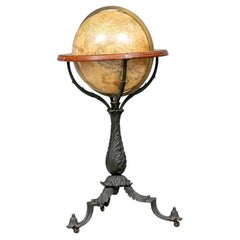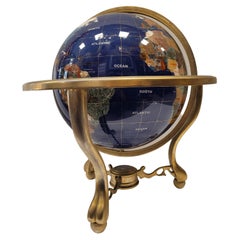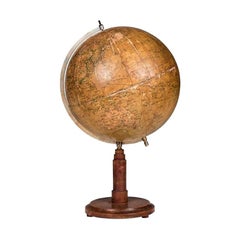Bronze Maps
2
to
1
1
2
2
2
2
2
47,209
5,337
91
31
31
1
1
1
1
1
1
Material: Bronze
Important Late 19th C. Terrestrial Globe on Stand for H.B. Nims After Copley
Located in Bridgeport, CT
Manufactured for H.B. Nims & Co., Troy New York, last quarter 19th c. After the original engravings by Charles Copley done in 1852.
Printed paper on wood with brass/ bronze meridian ring and a flat circular printed center horizon ring on wood labeled with the months of the year with notes. Mounted on a fine leafy iron baluster...
Category
Late 19th Century American Victorian Antique Bronze Maps
Materials
Bronze, Iron
Miniature Terrestrial Globe Newton & Son London, Post 1833, Ante 1858
Located in Milano, IT
Miniature Terrestrial Globe
Newton & Son
London, post 1833, ante 1858
Paper, papier-mâché, bronze and wood
It measures: sphere diameter 2.95 in (7.6 cm); diameter of the wooden base 6.02 in (15.3 cm); height 8.36 in (21.24 cm).
Weight: 2,067 lb.
State of conservation: the globe still bears its original paint, but has various small gaps, abrasions and stains on the surface.
The globe is hinged with two pins at the meridian circle, which is in turn inserted perpendicular to the horizon circle; this is supported by four semi-arches connected at the bottom by a small goblet-shaped foot, resting on a wooden bell-shaped base.
Apart from the wooden base, the entire support structure is made of bronze; on the foot there are the scale reproductions of a compass, a telescope and an open book.
The sphere is made of papier-mâché and is covered with twelve printed paper gores.
In the North Pacific Ocean the globe bears a cartouche with the inscription (about 30% of the writing is illegible, but the missing parts can be easily integrated based on the rest):
NEWTON’S
New & Improved
TERRESTRIAL
Globe
Published by Newton & Son
66 Chancery Lane
LONDON
On the globe, much of central Africa is empty and the great lakes Tanganyika and Victoria are not marked (Europeans would begin to explore the area after 1858). Canada is called "British Territory" and Alaska "Russian Territory" (it would become part of the United States in 1867). Australia already bears its modern name (until 1829 it had been called New Holland) and its coasts are completely designed; Tasmania is listed as an island (Matthew Flinders circumnavigated it in 1798). The routes of Cook's various voyages are plotted; both the route followed by Biscoe in 1831 and the "Land of Enderby" which he discovered on the coast of Antarctica, south of Africa, are marked.
Bibliography
P. Van der Krogt, Old Globes...
Category
1840s English Early Victorian Antique Bronze Maps
Materials
Bronze
Related Items
Large and Extremely Rare Terrestrial Globe by Newton
By Newton Globes - Planer & Newton
Located in Lymington, Hampshire
A large and extremely rare 24-inch terrestrial globe by Newton
Our most magnificent and rare globes were a pair of 24-inch Newton globes.
These too were updated in 1852 (terre...
Category
Mid-19th Century English Antique Bronze Maps
Materials
Mahogany
Antique Cylinder Sundial Late 19th Century
Located in Firenze, IT
Shipping policy No additional costs will be added to this order. Shipping costs will be totally covered by the seller (customs duties included).
A boxwood cylinder sundial, also kn...
Category
Late 19th Century British Late Victorian Antique Bronze Maps
Materials
Wood, Paper
19th Century German Miniature Pocket Terrestrial Globe
Located in Essex, MA
A miniature 19th century 3.5 inch diameter pocket terrestrial globe by C. Abel-Klinger, Nuremberg, Germany, in English for the English speaking markets. Signed with cartouche reading...
Category
1880s German Antique Bronze Maps
Materials
Brass
Late 19th Century English Victorian Smoking Stand with Carriage Figure
Located in New York, NY
English Victorian smoking stand on rectangular oak carved base with metal figures and horse drawn fire engine & various smoking accessories.
Category
Late 19th Century British Victorian Antique Bronze Maps
Materials
Metal
Fine Pair of Floor Globes by J & G Cary, Dated 1820 and 1833
Located in Lymington, Hampshire
A fine pair of 15 inch floor globes by J & G Cary, dated 1820 and 1833, each set into a mahogany stand with a vase shaped support and three legs centred on a compass, one with a labe...
Category
Early 19th Century English Regency Antique Bronze Maps
Materials
Mahogany
Vernier Protractor by Newton & Co of London
Located in London, GB
A mid 19th century brass Vernier protractor by Newton & Co of London.
With two screw in fixing points.
Signed: Newton & Co 3, Fleet St, London
Marked with Broad-Arrow: WD 5679.
Category
Mid-19th Century English Antique Bronze Maps
Materials
Brass
Antique Hammond's 6-Inch Terrestrial Globe on Stand
Located in Philadelphia, PA
Offered here for your consideration is, A fine antique 6-inch terrestrial globe.
Additional Details:
By C.S. Hammond & Co.
The globe likely dates from 1927 to 1930 due to the ...
Category
20th Century Unknown Art Deco Bronze Maps
Materials
Wood, Paper
Antique Kittinger 8-inch Terrestrial World Globe on a Mahogany Wooden Stand
Located in Philadelphia, PA
A fine, antique 8 inch terrestrial globe.
Manufactured by Kittinger Company, Inc. (in collaboration with the publishers W. & A.K. Johnston, Ltd. of Edinburgh, Scotland).
On a turne...
Category
Early 20th Century Bronze Maps
Materials
Mahogany, Gesso, Wood, Paper
H 18 in W 11.5 in D 11.5 in
A truly delightful miniature terrestrial pocket globe
Located in ZWIJNDRECHT, NL
A truly delightful miniature terrestrial pocket globe in a celestial case, 3 inches / 6.8 cm. The globe consists of 12 wonderful varnished, engraved hand-coloured gores that stretch from pole to pole. In the original case of black fish-skin with a brass hinge and two brass hook-and-eyelet closures, case with a unique silver plaque which reads:
"B. Bellchamber S. King - Gul's Fox Summum Geographicum Praemium Pares Meruere". *
[This very roughly translates to:]
"B. Bellchamber S. King - Gul's Fox Earns Top Geographical Peers Award".
*Is it too much to suppose and speculate that this wonderful silver plaque attached to the outer case is in recognition of a [geographic?] scholastic achievement? The prize awarded to the lucky recipients (B. Bellchamber & S. King?) is this globe?
This terrestrial globe has two repairs; to the area concerning the British Isles, and also to parts of Europe and Scandinavia (with some loss). There is some slight loss to a portion of North America, and there is a crack to the northern portion of South America. It is partly worn in other places and has some slight spotting. It is lacking the axis metal pin, and the two holes that normally allow for this pin have been closed. The case is split and segmented, partly rubbed and worn with cracks, (as is usual.) The case will close. There is some minor chipping and cracking to the outer rim of the inside of the case.
About Pocket Globes.
It is generally thought that Joseph Moxon brought pocket globes to England in the late seventeenth century. These globes usually consist of a terrestrial sphere of about 7.5 cm in diameter that fits into an outer case (usually made of fish-skin). The interior of this case often bears bright, colourful celestial cartography, so you effectively have the celestial heavens surrounding the terrestrial earth.
Pocket globes, although highly desirable, are for all intents and purposes somewhat impractical, as their size makes accurate calculations impossible. Few, if any, pocket globes came with accompanying booklets, so it is hard for anyone to know who used them and for what purposes.
Pocket globes could simply have served purely as status symbols for wealthy gentlemen, who had an interest in geography or astronomy. The fields of geography and the sciences were quickly advancing during this period. Alternatively, pocket globes could be seen as a tool used in children’s education, especially when you think that they are construction from cheap materials such as papier-mâché.
Points of Interest.
This particular globe shows California as a peninsula, whereas previously it had been depicted as an island – a misconception dating back to the sixteenth century; it has the northwest coast of America simply as "unknown parts."; - due to a profound lack of knowledge of the region; the track of Admiral George Anson’s circumnavigation of the world (1740-44) is drawn – Anson led a squadron of eight ships on a mission to disrupt or capture the Pacific Ocean possessions of the Spanish Empire, for emphases, the trade winds are indicated by red arrows. There are three large lakes engraved in Africa that may longer exist.
The Celestial Gores.
The celestial gores, housed within the case, are fun and eye-catching both in their display and in their content. Constellations and both hemispheres and are represented.
Gemini, Cancer, Virgo, Orion, Andromeda, Taurus, Leo, Ursa Major etc in the north, and Scorpio, Libra, Canis Major etc in the south.
A celestial globe is a mapping of the stars, and has been used since classical times. Celestial globes were first used by Greek astronomers, and later by the Islamic world, where the earliest known globes date from the eleventh century. The stars were thought to sit on the surface of a giant sphere around the earth, and the constant movement of the stars each night and throughout the year appeared to be caused by this giant sphere slowly turning overhead. In line with its counterpart, the terrestrial globe, celestial globes are mapped by a north and a south pole, an equator, and lines of latitude and longitude.
The Terrestrial Globe.
The North Pole encompasses the Arctic Circle, Baffin Bay (Canada), Iceland, Greenland, northern Siberia and Nuova Zembla.
Europe shows the Dominion of Muscovy (a principality of the late Middle Ages centered on Moscow), Turkey, the British Isles, Italy etc.
Africa highlights the Barbary coast, Biledulgerid (a former country in North Africa), the Zaara Desart (Sahara Desert), Negroland (an archaic term in European mapping referring to large portions of West Africa), Guinea, Ethiopia, Congo, the islands of the Azores and the Canaries.
Australia (New Holland) shows the outdated cartography of an incomplete coastline; The West Australian and Northern Territory coastlines are in full, however, there is no connected mainland coastline from South Australia up to Northern Queensland. Papua New Guinea is still thought to be a part of the Australian mainland. A portion of Tasmania’s coastline is engraved. The only places/regions mentioned are: Dimens Land and Carpentaria in the north; Lewins, St. Francis, Mary’s Island, South Cape, and Dimens Land in the south.
Interestingly, a place named Hartog’s Island is mentioned off the West Australian coast. This island has a unique place within Australia’s history as it is the first recorded European landing on Australian soil in 1616 by the island’s namesake, Dutch captain Dirk Hartog...
Category
Mid-18th Century British Dutch Colonial Antique Bronze Maps
Materials
Other
Miniature globe in aturned and stained beech
Located in ZWIJNDRECHT, NL
Newton & Son pocket globe
London, 1838
Miniature terrestrial globe with a diameter of 2 inches / 5 cm.
In a turned and stained beech two-section case, 3,95 inches / 10 cm. high.
Category
19th Century British Late Victorian Antique Bronze Maps
Materials
Fruitwood, Paper
Dutch Miniature Terrestrial Globe on Wooden Base, circa 1900
Located in Delft, NL
Dutch miniature terrestrial globe on wooden base, 16 cm high
A miniature globe made of papier mâché with Dutch text on a wooden stand,
circa 1900
Used object
The measurements...
Category
19th Century Dutch Antique Bronze Maps
Materials
Wood, Paper
16-Inch Terrestrial Globe 1986 National Geographic
Located in Ottawa, Ontario
A 16-INCH TERRESTRIAL GLOBE 1986
NATIONAL GEOGRAPHIC
Large terrestrial globe with paper gores
on a stylish black lucite base
scale 1: 31,350,000
18" inches, (45.5cm.) high.
16" in...
Category
Late 20th Century American Modern Bronze Maps
Materials
Metal
Previously Available Items
20th Century Lapis Lazuli Earth Globe, Marquetry in Precious Stones
Located in Valladolid, ES
Amazing Large handmade earth globe with lapis lazuli background and marquetry with semi-precious stones, they are applied following the jewelry technique called "Pietre dure", carefu...
Category
1980s French Mid-Century Modern Vintage Bronze Maps
Materials
Bronze
19th Century Russian World Globe Made in Germany by Syrkin GmBH
Located in Marbella, ES
19th Century Russian world globe with wooden base, made in Germany by A. G. Syrking GmbH.
Category
Mid-19th Century Russian Antique Bronze Maps
Materials
Bronze
1900s Russian World Globe Dioram Made of Wood and Paper
Located in Marbella, ES
The wooden base has an embedded compass and supports the globe on a bronze stand.
Category
Early 20th Century Russian Bronze Maps
Materials
Bronze
Antique Bronze Celestial Globe Sphere Engraved Holy Islamic Sites, Mumbai
Located in South Burlington, VT
An unusual one-of-a-kind bronze globe or sphere Intricately engraved in commemoration of the holy sites of Islam , India, early 20th century.
Provenance: Old Massachusetts collecti...
Category
Early 20th Century Indian Bronze Maps
Materials
Bronze
Rouge Marble Globe Clock
Located in New Orleans, LA
This extraordinary globe clock is an impeccable example of the complex artistry of French timepieces. The terrestrial globe is rendered in painstaking deta...
Category
19th Century French Other Antique Bronze Maps
Materials
Marble, Silver, Bronze
Midcentury Replogle Diameter Globe on Stand World Classic Series
Located in New York, NY
A vintage 12" diameter floor globe on a metal stand "World Classic Series" with cartography by LeRoy M Tolman. USSR is still on the globe. Good vintage ...
Category
Mid-20th Century American Mid-Century Modern Bronze Maps
Materials
Bronze
Recently Viewed
View AllMore Ways To Browse
Antique Sailing Maps
Antique Sailing Map
West Coat Of Arms
Bay Area Antique Furniture
Greek Asia Minor
Hemisphere World Map
Antique Maps Canada
Antique Map Canada
Canada Antique Map
Speed Map
Charing Cross
Malaysian Antique
West Indies Map
Blaeu World Map
Map Of Brazil
Map Huge
Antique Portuguese Plates
Antique Maps Of Canada




